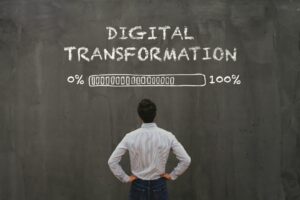The Overlooked Function of Digital Transformation in HR

Tech spending in HR is grinding to a halt at the worst possible time.
Teams are being called upon to increase productivity and cut costs, yet HR is frequently excluded from company-wide digital transformation. It’s well-known that automation and digitalisation can boost efficiency and simplify workflows. But instead of letting tech lift the burden, HR professionals are distracted by busy work and outdated systems.
The exclusion is tinged with irony. HR professionals are essential for making sure employees are engaged and on board with transformational change. But when it comes to digital transformation inside the department, HR is so often overlooked.
The pandemic amplified the need for digital HR. Remote work, virtual onboarding, and employee wellbeing – all people-centric functions – demanded an overnight migration to the virtual world. As digitalisation persists across companies and industries, it’s time for HR departments to catch up.
What Analogue HR Departments Are Missing Out On
The benefits of digital HR stack up. By automating some of the day-to-day admin, and introducing autonomous workflows for recruitment, onboarding, and employee benefits, you can create more capacity in your team (without hiring an extra pair of hands).

Here are three examples of how digital HR benefits the whole company:
Increased Capacity
Today, many HR professionals are trapped in an endless ream of admin and repetitive work. Instead of focusing on strategic goals like developing the company culture or improving employee experience, teams are snowed under with compliance and payroll tasks.
Embracing digital HR gives teams more time to focus on the ‘human’ aspects of HR. Manually updating employee records and managing annual leaves are important tasks, but they don’t have to be performed by a human.
Figuring out how to engage employees with a new learning and development programme, or strategising in response to an employee survey requires human HR minds on the job.
Better Relationships
As teams become more distributed, having a human resources function focused on the people can help to reinforce relationships and culture that transcends the physical office.
Historically, interactions with HR teams have had negative connotations. Often, employees only engage with HR when the rules are broken, compliance is challenged, or disciplinary action is necessary. As a result, people outside of HR don’t always see the strategic and empathetic work professionals are doing inside the department.
But smoother, digitised workflows could help to improve relations between HR and wider teams. By automating some communications and replacing manual processes with simple digital systems, you can give employees a seamless way to engage with HR. Booking annual leave or updating employee records requires a few clicks – instead of a few emails.
With better systems to manage the admin, you can work with employees directly on the things that matter most to them – such as onboarding, learning and development, and performance.
Candidate Engagement
In another universe, human resources could be retitled as human relations. For job applicants, HR is often the first department candidates are properly introduced to – the first glimpse of what working at your company looks like.
Today, many businesses struggle to keep candidates engaged. One survey from 2022 found that 78% of job seekers would drop out of a recruitment process that’s too lengthy or complicated.
Technology can simplify and expedite hiring procedures. You can automate email updates and interview scheduling so candidates are kept in the loop. As well as centralising all candidate information, so you can easily filter applicants and keep the process moving.
Digital HR teams can create a positive ripple effect for people outside of the department. Just make sure you avoid siloing your efforts.
Microsoft Breaks Down Projects Silos for Digital Transformation Success
Microsoft CEO Satya Nadella sees purpose and culture as the ultimate drivers of business success.
Before the pandemic, the Microsoft Digital Employee Experience team was investing heavily in search and collaboration tools. The HR team was working on a learning and development tool. Company-wide town halls, an internal SharePoint redesign, and an employee mobile app were also in the works.
Employee experience was the North Star. But instead of approaching it collectively, teams moved forward in isolation. This led to overlapping work and duplicated efforts.

The teams recognised this before it was too late. Acknowledging the complexity, they decided to seek out simplicity instead.
Simplicity came in the form of one centralised platform, combining the efforts of digital, HR, and employee experience teams: Microsoft Viva.
Silos create complications. But collaboration fuels simplicity. Before embarking on your digital transformation journey, coordinate efforts with the wider company. Digital transformation can’t happen without cultural change – and as stewards of culture and employee experience – HR teams need to unite all corners.
How HR Pros Can Get Up to Speed on Digital Transformation
Step away from the software and investigate the digital needs of your department.
Ask yourself:
What tasks are you spending the most time on?
- Is it possible to automate them?
Which processes do your team struggle to follow?
- Where do mistakes happen? When do tasks get missed?
Which processes do employees struggle to follow?
- Where do mistakes happen? At what point do employees become disengaged?

You might already have some ideas driving your digital transformation ambition. But make sure to validate these with an employee survey.
Conducting a survey will also help you understand which aspects of HR are and aren’t working for employees. For example – if the majority of employees struggle to coordinate their annual leave, this should be one of your top priorities.
Once you’ve identified the challenges you want to solve, start with one HR tool – and focus on integrating it properly. Use software to its full potential before adding more tools to your stack. If you want to get it right the first time, introduce software trial periods and gather employee feedback before committing.
As Microsoft’s case study demonstrates, a robust digital transformation approach encompasses multiple departments and voices. Come together with leaders from across the company to see which digital tools and workflows they’re having success with. See if you’re able to implement them before adopting new ones.
This has the double benefit of being more cost-effective and supported by internal experts who already know how to use the software.
The final step is the hardest one. HR professionals must challenge siloed working and demand a seat at the table for wider digital transformation plans. By understanding company goals, you can tie digital transformation efforts to organisational ambitions – and play an integral role in achieving them.
Taking on technology is a top priority for CEOs in 2023 – it’s time businesses start supplying their HR teams with the digital tools for the job.
HR Is Critical For Digital Transformation Success
HR plays a critical role in ensuring digital transformation projects are successful. As a company-wide touchpoint, HR professionals encourage employee buy-in and engagement during business transformation.
But without the right digital tools, HR teams will struggle to support company digital transformation and department-level change. A shift in thinking is overdue. It’s time for HR professionals to embrace their role as change agents in the digital era.
